Recent Articles
-
Finding her better Half
-
Orion Magazine Presents Landscape and Loss
-
Alphabet of Light, #15, by Kirsten Rian (Aaron Vincent Elkaim)
-
10th Annual Lucie Awards 2012
-
To Retrieve and Protect: Stacy Lynn Waddell Interviews William Cordova
Categories
- #SANDY
- 2016
- 27th International Festival of Photojournalism
- Aaron Vincent Ekraim
- Africa
- AIPAD
- Almond Garden
- American Photo
- Anna Beeke
- Aperture
- Art Desks
- Artist Events
- Artist talk
- Award
- Awards
- Barmaid
- Barney Kulok
- Behold
- Best of 2015
- Book Launch
- Book release party
- book signing
- Book signings
- Book-signing
- Bryan Schutmaat
- Call for applicants
- call for entries
- Cara Phillips
- CDS
- Chicago
- ClampArt
- Closing Exhibition
- Competition
- Conservation photography
- Contests
- Cowgirl
- Critical Mass
- Cyril Christo
- Daily Mail
- Daylight
- Daylight Books
- Daylight Digital
- Daylight Digital Feature
- Daylight Photo Awards
- Daylight Project Space
- dj spooky
- Documentary Photo
- DPA
- Dread and Dreams
- E. Brady Robinson
- Eirik Johnson
- Elaine Mayes
- Elinor Carucci
- Events
- Every Breath We Drew
- exhibit
- Exhibition
- Exhibitions
- Fall 2015 Pre-launch
- Festivals
- Film Screening
- Film screenings
- Fine Art
- Flanders Gallery
- Fotobook Festival Kassel
- Françoise Callier
- From Darkroom to Daylight
- Frontline Club
- Gabriela Maj
- Gays in the Military
- george lawson gallery
- GuatePhoto
- Guatephoto Festival
- Hariban Award
- Harvey Wang
- hochbaum
- Home Sweet Home
- Huffington Post
- Hurricane Sandy
- Interview
- J.T. Leonard
- J.W. Fisher
- Janet Mason
- Jess Dugan
- Jesse Burke
- John Arsenault
- Jon Cohen
- Jon Feinstein
- Katrin Koenning
- Kuala Lumpur Photo Awards
- Kwerfeldein
- L'Oeil de la Photographie
- LA
- Landmark
- Leica Gallery
- Lenscratch
- LensCulture
- Library Journal
- Lili Holzer-Glier
- Lori Vrba
- Lucas Blalock
- Malcolm Linton
- Marie Wilkinson
- Mariette Pathy Allen
- Michael Itkoff
- Month of Photography Los Angeles
- Mother
- Multimedia
- Nancy Davidson
- New York
- New York City
- News
- NYC
- ONWARD
- Opening
- Opportunities
- Ornithological Photographs
- Out
- Party
- Philadelphia
- Photo Book
- Photo Booth
- photo-book publishing
- PhotoAlliance
- Photobooks
- Photography
- Photography Festival
- photolucida
- Poland
- portal
- Pre-Launch
- Press
- Prize
- PSPF
- Public Program
- Raleigh
- Rayko Photo Center
- Recently
- Rencontres De Bamako
- Reviews
- Robert Shults
- Rockabye
- Rubi Lebovitch
- San Francisco Chronicle
- Seeing Things Apart
- SF Cameraworks
- silver screen
- Slate
- slideluck
- Sociological Record
- Soho House
- spring 15
- Spring 2016
- Stephen Daiter Gallery
- Sylvania
- Talk
- Tama Hochbaum
- The Guardian
- The Moth Wing Diaries
- The New Yorker
- The Photo Review
- The Solas Prize
- The Superlative Light
- The Telegraph
- TIME
- Timothy Briner
- Todd Forsgren
- Tomorrow Is A Long Time
- TransCuba
- Upcoming events
- USA Today
- VICE
- Vincent Cianni
- Visa Pour L'Image
- Vogue
- We Were Here
- Wild & Precious
- Wired
- Workshop
- Zalmai
- Zofia Rydet
News
Finding her better Half
Posted by Daylight Books on
If self-portraiture is often an exercise in vanity, Julia Kozerski's series, Half, is rather like a surrender to humility. When she started documenting her weight loss in 2009, the goal wasn't parading her new shape, but accepting it. Superficially, losing half of your body mass when you're morbidly obese is an incredible accomplishment; the reality of it, portrayed by Kozerski, is also a story of mourning your former self, and struggling to recognize the new one.
While studying for her BFA at the Milwaukee Institute of Art Design, she realized that using herself as a photography subject would help her emotionally detach from her self-image issues. Her body in a mirror was not the same than her body in a photograph. Her skin, stretched and marked, became a muse instead of an embarrassment. "Photographing myself allowed me to remove myself and look at myself more objectively. It allowed me to "speak" without using words. It was embarrassing at times, especially in the most intimate of moments with my husband. But the images I took allowed me to express how I was feeling without uttering a sound", says Kozerski.
A camera is an interesting weapon of self-acceptance, and she did not hold back. Her images are merciless. Both her studied compositions and her light, sometimes wistfully soft but often almost cruel, work as a jewel case for her folds and stretch marks. So much so that they become fascinating, beautiful even. Her close-ups are as riveting as macros of foreign organisms; almost scientific in detail, yet infusing the viewer with an almost poetic urge to touch. Her wider shots tell complex narratives, reminders that a body has a history, filled with contradictory emotions - like we all are, in the end: ambivalent, vulnerable and insecure, but proud and in need of recognition.
If at first she wasn't sure the public would relate, her project soon garnered much interest and she was motivated to give it her all. "When I began slowly introducing my images in critiques, I was flooded with questions. I thrived on the dialogue. People wanted to know more, they wanted to see more ... so that is what I gave them." The success of her self-portraits is not just about the contemporary issue of weight loss; it is the universal quest for self-acceptance, self-questioning, self-observing. It is about death, renewal, success and failure. "You don't need to have lost weight to understand and relate to my work, you just need to be human."
160 pounds later, she has also shed the unease and the modesty. She isn't photographing herself anymore, but the process of self-exploration. Thanks to Half, she says, "I embrace my body, perceived "flaws" and all. My womanly shape is unlike models in our magazines nowadays and is quite reminiscent of those found in paintings throughout art history." Yes. Her work returns the human body to its original grace, away from plasticity and perfection; life through her lens, warts and all, is a work of art.
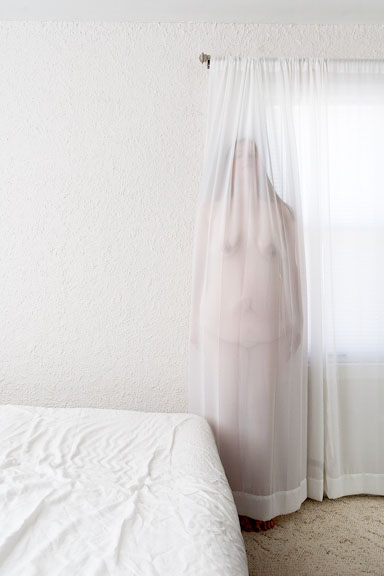
Whitewash
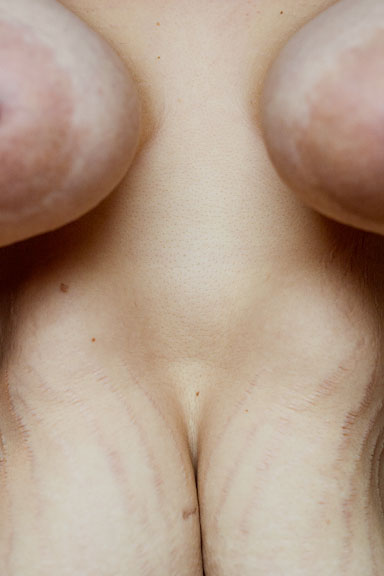
Casing No. 2
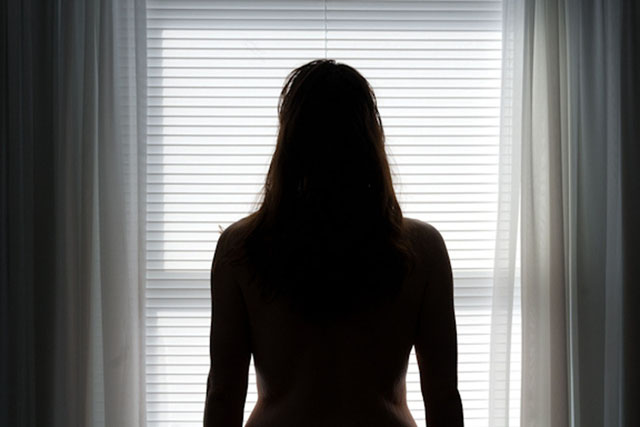
Vestige
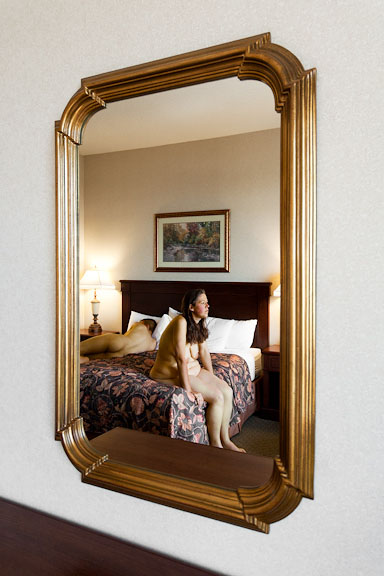
Surrender
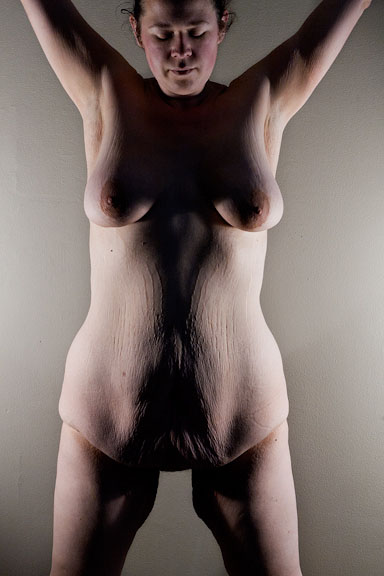
Ruins No. 2

Weighing
Julia Kozerski's website can be found at http://juliakozerski.com/
Orion Magazine Presents Landscape and Loss
Posted by Daylight Books on
How is the hallowed tradition of landscape photography changing? Where can its most exciting new practitioners be found? How does it intersect with documentary photography?
This Thursday, October 23rd, Join Orion Magazine for Landscape and Loss, a special live web event featuring photographer Matt Black, to discuss photographic projects which depict landscape to tell a story.
Matt Black's most recent body of work, After the Fall, chronicles the story of Santiago Mitlatongo, a town that sits on a landmass that is moving about a yard per day.
Says Black, "While people were busy salvaging what they could from their toppled houses, they saw that the entire horizon had shifted—the forest above town didn’t quite line up any more, and the road leading out wasn’t just torn up, but no longer even pointed in the right direction. The chasms and sinkholes continued to grow until they formed a vast semicircular tear surrounding the village."
To register for the conference, https://cc.readytalk.com/cc/s/registrations/new?cid=ylw3l7h8d51s
Tuesday, October 23rd at 7PM
Alphabet of Light, #15, by Kirsten Rian (Aaron Vincent Elkaim)
Posted by Daylight Books on
Photograph by Aaron Vincent Elkaim
Traplines
Sometimes it’s called “Aboriginal possession,” or “Indian title,” the historic right for Natives to use and occupy the land of their ancestors--and this includes trapping without interference. Traplines are areas where this right to trap fur-bearing animals is upheld. And if industry uses traditional lands, the person holding the trapping rights is often compensated.
The Athabasca oil sands in northern Alberta, Canada, are the second largest oil reserves in the world next to Saudi Arabia. The First Nations Reserve of Fort McKay is surrounded on all sides by oil extraction plants, a sharp-edged and disparate juxtaposition from as recently as 40 years ago, when no roads led to or from the region. In the 1960s, the Cree and Dene people lived off the land, and had no running water. Traditionally, they’d used tar sands to waterproof their canoes. Today, the Fort McKay Group of Companies (formed in 1986 by the native people to provide oil industry services) earns over $100 million annually from oil company business contracts and employment. Individuals are compensated directly for trapline use, and the group as a whole if reserve land is used or compromised.
A space exists between that past and this present. And it is there that photographer Aaron Vincent Elkaim looks. The 2012 Daylight Magazine Photo Award winner spent four months living with the indigenous people of Fort McKay, exploring the blurring lines of oil industry partnership and economic prosperity, that at times work against age-old land traditions and values.
“There is this notion that Native people have a cultural and spiritual tendency to be stewards to the land. In McKay they are profiting off of its destruction. I knew the story had to be complicated, so I just gave it time to be revealed,” Elkaim tells me.
It is his patience that allowed an astounding level of depth and complexity to be shown in his project Fort McKay: Sleeping with the Devil. “I knew landscape would be a big part of the project, but I had no idea how the reportage would play out, or the access I would get. I just trusted my intuition that there was an important story here and that it would hopefully be revealed to me. So it was much more a process of discovery than knowing what the story was and trying to photograph it,” he continues.
“Before being accepted into the community I spent two weeks sleeping in a camper trailer I had towed up there and parked just past the reserve. I had found it extremely difficult to meet anybody, and get traction within the community, as there were no local hangouts. I just wandered the streets getting glared at mostly...Luckily before long someone followed me back to my trailer one morning in a very threatening way (he saw my out of town plates and thought I may have been a drug dealer). I introduced myself to him; before I knew it I was living with his mother where I spent the next four months.”
The first exploratory oil processing of the area goes back to the 1930s, and by the late 1970s the second major oil sands plant was completed. In 1982 the Fort McKay First Nation blocked the access road in protest for not having enough voice or benefit from the burgeoning industry. They were offered a water treatment plant by the provincial government and several years later formed a holding company to manage their involvement and profits.
“In a country where the norm for Native reserves is high poverty, unemployment and dismal housing, Fort McKay is marketed as a success story, but the people here know the truth is much more complicated and as their land and culture deteriorate there is little faith much will remain for future generations,” Elkaim says.
“It might be part of the human condition, an aspect of our ego. Right now we are in the dogma of Nationalistic Capitalism, and we are most certainly destroying each other and even ourselves to protect it. Fort McKay was an interesting experience in shaping my perspective in regards to this. It is a place where historically the people lived off of the land and each other. Their belief was to care for one another and Mother Earth and in turn Mother Earth would care for them and their future generations. Of course that life would have always been a struggle. Today they have all the comforts of the modern world, but when asked about the future of their great-grandchildren they wonder what they will have if they cannot drink the water, pick berries, eat fish, or hunt moose. The disrespect for Mother Earth has sealed the fate for future generations and they very are aware of this. Their awareness gives me hope that maybe things can change.”
There’s an edge to survival. What happens when needs are met spiritually but not tangibly in a food/shelter/resources sort of way? Elkaim’s images are without judgement. His unique ability to pan wide and to look hard, to look with hope, to look with regret and sadness, to look with belief, is singular. Survival depends on an enmeshment of factors within our control and out of our control. Sometimes there’s a rip in the net. Sometimes the line goes slack. Sometimes the current pulls so hard the line breaks. What happens then? Elkaim asks all these questions and more in his photographs. The reconciliation between right and wrong, between looking honestly at the surrounding factors over which you have no control, and then trying to exert some control over them--these are questions of survival.
As a photographer, Elkaim particularly honors process, and this project deftly manages a multiplicity of themes and content threads by following through on his ideas, listening to his gut, and keeping his eyes open for what finds him. He tells me about not knowing how specifically the project would play itself out, about trusting fate and coincidence.
“I found I simply had to let go of trying to construct the story and simply had to wait for it to be revealed to me. Sometimes I wouldn’t take a decent picture for a week or more. Being in a small community for so long there was so much repetition. As a photographer you’re always looking for something new to catch your eye to add to the story, but I found that I was often repeating the same steps with people and scenarios. Really I was just hanging out, but in doing so I began to understand the community and the story, and through that process I gained trust. That trust led to photographs, and my understanding gave me the ability to realize the symbolism in the pictures that appeared before me. The time also allowed for synchronicities to happen, for that one shot and situation to materialize often when it was least expected.”
He discusses his process further, “Shooting film was also a different experience for me. Not being able to edit on the go allowed me to stay in the moment. It kept me from trying to construct the story with the images I had already taken, going to my laptop and disconnecting from my surroundings. I think that was very important. It was difficult to know when it was time to go, or to even know what I had! So I decided to just trust my gut that I would know when it was time to leave.”
“What I love about photography and what keeps me practicing is the freedom it provides to explore and interact with the world. Its a spiritual experience for me, you have this intention to understand and tell a story, then one random thing leads to the next and at the end you walk away with this body of work and experience that you could have never fully foreseen, where that leads you next is always unknown as well…The documentary photographer is looking to communicate a story, but before that he is looking to be informed himself.”
“There is this idea that photography can change the world. I believe that is true, but I don’t think we should expect to perceive that change. We just have to have faith that our work does contribute to it.”
Aaron Vincent Elkaim’s website is: http://www.avephoto.ca/portfolio/
To view Daylight’s multimedia piece on this project, see: http://daylightbooks.org/podcast/october2012
10th Annual Lucie Awards 2012
Posted by Daylight Books on
The 10th Annual Lucie Awards is upon us! Every year, the Lucie Awards strives to honor master photographers as well as emerging photographers, both of which have contributed greatly to the passion of photography. Through nominations and the Lucie Advisory Board, the chosen honoree's will be celebrated at an annual gala event in their respective categories. The Lucie Awards are the photographic equivalent to the Oscar's for cinema, so get your tickets!
Also, check out the seminars that will be back to back today at Pier 59 Studios West in Santa Monica, California! You can check out the seminars here: http://www.facebook.com/luciefoundation/events
Tickets and information for the Lucie Awards:
To Retrieve and Protect: Stacy Lynn Waddell Interviews William Cordova
Posted by Daylight Books on
Artist william cordova’s varied practice includes drawing, sculpture, video, film and photography. Photography has been a critical practice for Cordova since the mid 1970’s. Since that time, he has maintained an archive of images that reflects his engagement with resistance and preservation. On a recent afternoon, I had an opportunity to speak with the artist about his relationship to pictures and the camera.
Stacy Lynn Waddell: You and I both maintain archives of 20th century photographs that appear in our work. I retrieve private images, domestic scenes and portraiture of Black life that are often found at antique shops, estate sales and other commercial venues. Where do you find your images?
william cordova: I have been archiving silver gelatin prints as source material for quite some time. I incorporate these images into my work in an abstract way. These images are usually from the Associated Press. Many of these images are widely distributed and are seldom copyrighted, that is why they are so accessible. As a result, I am able to acquire them through the Internet and other means.
SLW: What types of pictures do you look for?
wc: Many of the images that I choose are part of the architecture of resistance. I use these images in my work, but I also need to find them for myself. I look for Native American images from the early to mid 20th century and rebellions in Los Angeles where Chicano and Black youth have organized and fought against military force. These tend to be images from the 1960’s, 70’s and 80’s. I look for examples of coalitions and try to retrieve images that are not usually a part of our consciousness.
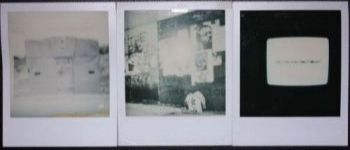
untitled (puertas)
SLW: Yeah-these images are not a part of our consciousness through very specific means. Photojournalists tend to format and present pictures as a specific type of information. This coupled with the proliferation of images on the Internet makes it easy for certain images to get lost in the shuffle of the rapid fire pace of production.
wc: My introduction to photography came through reading about US history events like the Civil War, WWII, etc. It was not about photography as an art form. That is how I learned that many of these documents that I was looking at were created for the camera. Many of these images were manipulated or staged. Now fast-forward to the 21st century and digital technology---Although these processes are a few steps beyond film, digital images still exist in the same realm for me as those Civil War images. Now anything goes. You can challenge the image, because it’s so abstract-its virtual. We question images more, but at the same time we don’t question them at all. What you see is not necessarily what you see. This is always in the back of my mind. What we are seeing is not necessarily clearly there.
SLW: What about truth and photography? If we think about photography as a mechanism of truth telling we have to consider the alliance between photography and journalism. This alliance trained the viewing public to accept information printed in black-and-white.
wc: In the early 20th century, not everyone could own a camera or afford to have a portrait taken. The mid 20th century brought about the mass production of cameras. Now everyday people could document their life, their family and their community. Once that happened, the two tracks of photography-private and public-were made clear. Private photos could be orchestrated, but not manipulated after the image was taken. Here, facts are un-manipulated. I consider these images more truthful. Public images taken by professional photographers (and amateurs as well) could be manipulated before and after the image was taken. Here, truth telling is questionable.
SLW: This is an important distinction that points back to the way that I acquire my images.
wc: The vernacular images that you acquire wind up in shops and at estate sales because much of the time in our communities, we do not pass on or teach the value of history. These images wind up in public spaces because someone has passed on, so they fall prey to a disposable society. No photograph in our home prior to 2000 is manipulated. We simply capture ourselves. This is why I lean more towards certain types of analog production-celluloid, Super 8, 16mm, 35mm and Polaroids. You can have a Polaroid 600 from 1975 and one from 2005 and they will both look exactly the same.

untitled (pachacuti, pachacuti, pachacuti)
SLW: There is a distinct element of compressed time that exists in your work-the act of archiving and the images that you create.
wc: I am trying to remove time. Much of the high-end photography (digital) tends to appear flat to me. These images are not an impression of anything, but a collection of elements that form an image through a succession of numbers and colors. This is a very different process than say the concept of the Pinhole camera that dates back to 1000 years ago. I tend to gravitate towards processes that create an impression with light through a window. When I look at older photographic images, I think about the fact that something has happened that is historical. These images carry a certain weight even though I may not understand or know where the image emanates from. Now everyone has a camera and ownership is not inherent in the image. We are desensitized because of the amount of appropriation that takes place. There is not as much personalizing. Also, the importance and process of editing has sifted.
SLW: That’s true. For many, D-E-L-E-T-E is a central component of the editing process. This was not the case when we were film dependent. What gets considered during the construction of a picture can now be left largely to the computer. There was a time that photographers worked more like plein air painters. Pictures were constructed in real space and real time with a different approach to observation. For many, that may still be the case, but the element of time has been compressed. I particularly love the nuances and inconsistencies of light in Polaroid images. You cannot completely control the medium. You have to succumb to the magic. It is one of the most beautiful forms of image making.
wc: There was an urgency to archive my family’s history. We were constantly moving around and not physically grounded to one place either Peru or the US. This happens to any group whose ownership of self, community or land is constantly being shifted, so when the wind blows you are always looking to hold onto the things as close to you as possible or else they will blow away. Photographs were the only things that I could grasp as a child. They were the only things that we brought to the US. They were the only things that we could afford. It comes down to economy also.
sintitulo (calle lunacalle sol)
SLW: Polaroids are not necessarily inexpensive though.
wc: That’s true, but they were considered cheap. They were a novelty item. They were not necessarily inexpensive to make, but they were immediate and that was important to me. With Polaroids we could retain certain things that related to our presence in the home. Each time we moved, we lost more so I tried to retain as much as possible.
SLW: How did you first acquire a camera?
wc: I never purchased a camera. There was usually one to be found around the house. I didn’t think about a camera in terms of a lens or as a mechanism, but as a box that I could put things in. A camera was a box into which time and space could be folded. Taking pictures was almost an act of desperation. Rather than actually owning the objects-I couldn’t-I took pictures of them instead. I could own the impression of the objects.
I still have those pictures from years ago. They are intensely personal. With Polaroids, I didn’t have to rely on someone from the drugstore to process my film. Many times the lab technician would act as an editor. They would not print certain images because they did not “see” anything on the film. The fact is they didn’t put any value in what I captured on film, so they felt free to edit my expressions. I would have to go back and give more instructions.
SLW: The camera has been a means of expression for you well before you became invested in a professional art practice. At what age did you begin taking these pictures?
wc: I started using a Polaroid camera in the early 1980’s. In the late 1970’s when we 1st came to the US from Peru, I was using a 35mm instamatic camera to re-photograph photographs that we did not have negatives for and photographing toys that we first bought when we arrived to the US. For economic reasons, we never had toys. I was also photographing clothes and family photos. This afforded me negatives of theses images. With negatives, I could reprint images if the actual pictures were lost.

untitled (sagginuoprising)
SLW: So fast-forward to now------you are still using Polaroids, 35mm film and Super 8 film. How does Super 8 film factor into your practice?
wc: Super 8 film is an extension of that box that I speak of. It is a similar process to 35mm film, but it is more like real time. It is not digital, so it is an actual impression of something that has occurred. It suspends your awareness of time.
SLW: If we think about it, we are in a similar place just beyond the advent of analog photography. Digital technology is progressing at a rapid pace, but it is still new.
wc: Today we assume that everything is happening now because of the progression of digital technology. History and time get lost. We are in the infancy stage of this new technology and everyone is looking for the next high-end mechanism. I am not interested in seeing the bumps on someone’s face. There is no reason for it. This high resolution does not necessarily reveal more. We are actually still in the 1800’s. I cannot embrace something that quickly and discard a process that has been vested for more than 100 years.
SLW: When I think of your work, I am always thinking of this idea of accessibility. There is something that is emotionally accessible in your work and I believe it is due to the choice of media-the analog. The analog is something that we understand. Analog processes tend to go right to heart of things in terms of imagery.
wc: Yeah------for me it speaks to disposability. The disposability of the medium and what I choose to photograph. Certain objects, places and monuments are considered disposable and are being erased and I am asking why that is the case. So, the medium and the image form a much larger question when I am building an installation. That is what I do not use digital media-it does not necessarily provoke one to inquire about the use of that medium. That question is an integral part of the content. Most people question my use of an outdated medium. My question becomes, why is it outdated?
SLW: The questioning is where the impact lies. You are right. We are skipping past that partly because of the way that digital media allows you to edit and parse through things so quickly that you miss it. You can easily dispose of the very thing that you are looking for.
wc: I am interested in asking why we are moving so quickly. Why move so fast?
SLW: Can we speak a little about your upcoming project at the Yerba Buena Center for the Arts in San Francisco, CA in October?
wc: The exhibition is entitled smoke signals: viviendo pa’ la ciudad. It will be on view from October 27-February 17, 2013. There are a few pieces that include 35mm slide projectors. Although the projectors have carousels attached, they only contain one slide. The projectors sit adjacent to one another on the floor. As a result, the projected images form a long landscape. Each image continues into each other. The images themselves are landscapes of various geographic regions of the world. I was trying to create a portal-a window. I see these works as sculptural. Slide projectors have a certain weight to them.
untitled (cebu, wounded knee y atlanta)
SLW: Absolutely----slide projectors are very powerful tools. The slide projector has been a favorite tool of mine for some time. The light and whir of the motor fascinate me.
wc: The sound is like breathing.
SLW: Yes!
wc: People usually relate slide projectors to meetings or institutions of learning. So the images that emanate from them are seen as very matter of fact or something meant to inform. I wanted to create an ephemeral monument. The projector itself has a physical weight, yet the image is only visible when the projector is on. When it is turned off, the image is gone and you are left with the memory of that image. There is fragility in recapturing something through memory.
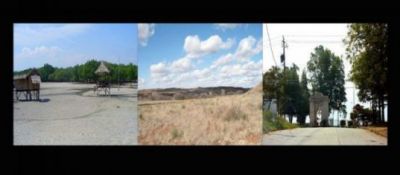
untitled (detail)
SLW: What are the locations that you have selected?
wc: The locations are as important as the projector itself. I have selected landscapes from the Philippines, Peru and Miami. These locations are landmark sites, but they are not widely known or studied.
SLW: The Sun is a big part of your work. It is an important aspect of photography and its symbolism shows up in various ways in your practice. Is this an important icon for you?
wc: It’s long been a part of my consciousness for spiritual reasons and it represents transformation. The three locations that I just mentioned are all about transformation-constructing transformation. Although they span across 600 years in terms of their significance, they are connected here through light projection that is directly and indirectly connected to the sun. They are reflections of something that is very spiritual and sublime. The sun also connects many cultures and continents. My ancestors valued the sun as well as Africans, Asians and other ancient cultures. These connections transcend beyond politics, nationalism and any other ism.
yawar malku (tupac, amaru, shakur)
SLW: I am stuck by the way that you have built an archive. Some of that urgency may be more a part of our consciousness due to disasters like Hurricane Katrina and the more recent tsunamis and earthquakes that have awakened us to the effects of disaster. What does it mean to lose everything or not have actual security in your existence?
wc: All of this has much to do with a history of fragmentation. Not all people understand this. I am not trying to deconstruct history with the photography that I have making for the last 12 years. The pictures are about taking certain fragments that come to me either by way of the Internet or as images that I have photographed or re-photographed and juxtaposing them. These relationships highlight a common sense that the images inherently posses. Reading them is like reading a newspaper without any text. The Internet allows for this. If you type in the word BUSH and search images for the word, many different interpretations will pop up from a burning bush to a politician and a beverage.
untitled (June 30-July 2, 1966)
SLW: But----when you look at them all together, they begin to make sense.
wc: Yes. Many images that I use are from the past, but many are from the present. I use Polaroids so that the images seem to emanate from the same time. So, I tend to juxtapose certain images that are related so that the viewer can reconsider past and present. It is important for me to present works where one is not valued over the other. I am trying to address commonalities. Understanding commonalities brings people closer together. There are many more connections that we sometime assume there to be.
William Cordova lives and works in Miami and New York. He graduated with a BFA from The School of the Art Institute of Chicago in 1996 and went on to earn an MFA from Yale University in 2004. From 1988 to 1994, he studied Medicine and Psychology at Miami Dade Community College. Cordova has held residencies at The Studio Museum in Harlem, New York; The Museum of Fine Arts, Houston; Headlands Center for the Arts, Sausalito; Artpace, San Antonio; and Skowhegan School of Painting and Sculpture, Madison, Maine; among others. He has exhibited in the US, Latin America, Europe, and Asia. His work is in such public collections as the Whitney Museum of American Art, New York; Solomon R. Guggenheim Museum, New York; Harvard University, Cambridge, Massachusetts; Yale Art Gallery, New Haven; Museo de Arte de Lima, Peru; Ellipse Foundation, Cascais, Portugal; Museum of Contemporary Art, Miami; and La Casa de las Americas, Havana, Cuba; among others. Cordova was included in Greater New York at MoMA PS1. In 2011 he was awarded the Joan Mitchell Foundation Grant, and was invited for his first solo museum exhibition in Europe, yawar mallku (royalty, abduction exile), at La Conservera, Murcia, Spain. He will begin a fellowship at the American Academy in Berlin in Spring 2013.


